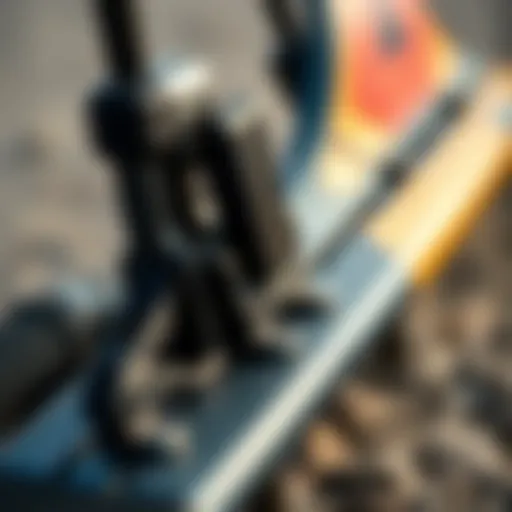Kite Surf Lessons in Miami: A Detailed Guide
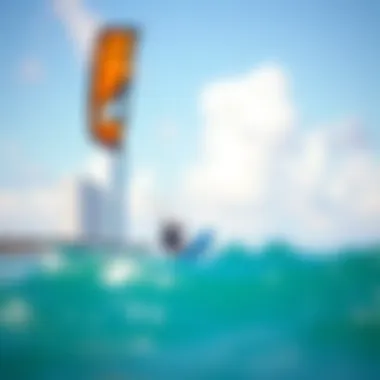
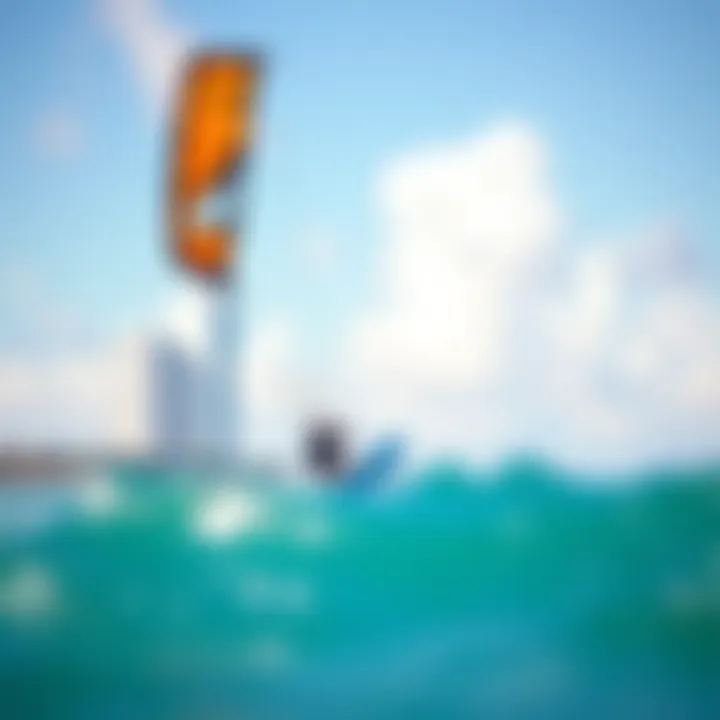
Intro
Kiteboarding in Miami is more than just a sport; it’s an exhilarating experience that brings together adventure, skill, and community. As you gaze out at the pristine blue waters, with palm trees swaying gently in the tropical breeze, it becomes evident why this city is a prime destination for both novice and experienced kite surfers. The conditions here are often ideal, striking a balance between wind and water that creates an inviting playground for enthusiasts.
Whether you’re standing on the sandy beaches of Key Biscayne or observing the vibrant community at Crandon Park, it’s undeniable that the kiteboarding scene thrums with life. This article aims to cut through the noise to provide you with a foundational understanding of what to expect from kite surf lessons in Miami—an indispensable guide that covers everything from gear insights to local culture and safety practices.
Gear Insights
Getting the right gear can make or break your kiteboarding journey. In Miami, the warm weather and consistent winds shape the choice of equipment. From harnesses to kites, here's a look at what’s essential to get started.
Latest Gear Reviews
When it comes to kiteboarding, staying updated on new equipment is crucial. The latest models often incorporate improvements in durability, control, and performance. The North Kiteboarding Neo, for instance, has garnered attention for its versatility and reliability across various wind conditions. Meanwhile, the Cabrinha Switchblade continues to be a favorite for its adaptability in both freestyle and wave riding. As a newcomer, it might be beneficial to try various models before making a purchase to get a feel for what suits your style best.
Essential Gear for Beginners
For first-timers, having a basic understanding of essential gear is invaluable:
- Kite: Choose the right size based on your weight and the wind conditions. A smaller kite works in high winds, while larger kites are better when it's light.
- Harness: The connection between you and the kite, get one that feels comfortable and fits well.
- Board: Beginner boards are usually wider, providing more stability while you learn.
- Safety Gear: Don’t skimp on a good quality helmet and impact vest to keep yourself safe.
- Safety Leash: This ensures your kite can be quickly released if things go pear-shaped.
It pays to rent gear when starting out. Many local schools offer packages that include everything you need, allowing you to test equipment before investing.
"The right equipment enhances not only your safety but also elevates your learning curve—don’t rush this crucial step in your kiteboarding journey."
Techniques and Tips
Once you have the gear, mastering the techniques is the next hurdle. Kiteboarding combines aspects of surfing, wakeboarding, and paragliding, creating a unique challenge.
Advanced Tricks and Techniques
Once you’ve got the basic skills down, it’s time to push your limits. Tricks like going for a jump or executing a backroll require a solid understanding of kite control. Practicing in calmer waters before attempting these stunts is advisable. Local kite schools often offer specialized classes focusing on advanced techniques, where you can learn under expert supervision.
Safety Practices for Kiteboarders
Safety should always be at the forefront of your kiteboarding experience. Here are some critical practices to follow:
- Know Your Limits: Especially as a beginner, avoid going into crowded or rough areas.
- Check Weather Conditions: Always glance at the forecast before heading out. Wind conditions can change rapidly in Miami.
- Stay Aware of Your Surroundings: Watch out for other kiteboarders, swimmers, or obstacles in the water.
- Pre-Flight Check: Inspect your gear before going out—look for any wear and tear.
Embracing the kiteboarding culture in Miami opens the door to innumerable experiences. Being part of a vibrant community makes the journey even more rewarding, with fellow enthusiasts ready to share their insights and support your growth.
In summary, kite surf lessons provide an incredible opportunity to dive into a thrilling sport surrounded by Miami's stunning coastline. With the right gear and techniques, your journey into kiteboarding will be one to remember, ensuring not only adrenaline-filled moments but also a strong connection to the community that makes Miami a top kiteboarding destination.
For those eager to learn more or share experiences, local forums or community pages on platforms like Reddit and Facebook can be fantastic resources.
Understanding Kite Surfing
Kite surfing combines the elements of surfing, windsurfing, and paragliding into a thrilling water sport that captures the essence of freedom and adventure. Understanding kite surfing is crucial for anyone looking to dive into this invigorating activity, as it lays the foundation for skills, safety, and enjoyment. Knowing how kite surfing works can also demystify the learning process, making it more approachable for newcomers.
For kiteboarders, several core aspects define the experience and its appeal:
- Connection with Nature: Kite surfing allows practitioners to harness wind and water, creating a unique synergy with the surrounding environment. The exhilaration of gliding across the water, powered by nothing but the wind, is unmatched.
- Physical Fitness: Engaging in kite surfing builds strength, endurance, and agility. Riders must use various muscle groups to control the kite and maneuver on the board, resulting in a full-body workout.
- Camaraderie and Community: Some of the best moments in kite surfing originate from the community built around it. Whether through lessons, competitions or casual outings, kiteboarders share their passion and knowledge, creating connections that enhance the overall experience.
Now, let’s delve deeper into the specifics of what kite surfing is and how it evolved over time.
Why Miami for Kite Surfing
Kite surfing in Miami isn't just a pastime; it’s an experience that melds the thrill of water sports with the vibrant energy of a coastal city. The combination of ideal weather, unique water conditions, and a rich kiteboarding community makes it one of the prime destinations for both budding enthusiasts and seasoned kiteboarders. Understanding why Miami is a preferred location can really make a difference in your learning journey, from enhancing skill acquisition to ensuring enjoyable sessions on the water.
Climate and Weather Patterns
Miami basks in a tropical climate, characterized by sunny skies and gentle breezes which suits kite surfing perfectly. The temperatures in this city rarely drop far below 70°F (21°C), making it accessible year-round. The wind patterns also play a pivotal role; predominantly, the easterly trade winds provide stable conditions that kite surfers crave.
On a typical day, the winds blow steadily at about 10-20 knots, which works remarkably well for both beginners and advanced riders. In terms of seasonal variations, between late spring and early autumn, winds can be more temperamental. However, it’s generally safe to say that any day aside from the dead calm days can turn into a thrilling adventure on the water.
"Staying aware of the weather and wind conditions is key. Miami may seem easy-going, but it pays dividends to keep an eye on the forecast."
Also, Miami’s wet season runs from May to October, bringing occasional storms that can whip up the waves but also produce some thrilling sessions once the storms clear up. Knowing when to go and which winds to catch can elevate your kite surfing experience considerably.
Unique Water Conditions
The waters around Miami offer a combination of flat water and small waves, catering to various skill levels. For beginners, areas with flat water, like Hobie Beach, allow for smoother learning curves. The calm conditions here mean that learners can focus on mastering the essential techniques without the extra challenges that choppy waves bring.
For the more advanced riders, spots like Crandon Park provide not only flat water but also the opportunity to ride larger swells that can excite even the most seasoned kite surfers. This diversity in locations means that you can switch it up based on your comfort level and skills.
Another significant factor is the warm water temperatures. Ranging from the low 70s to high 80s °F, the water feels inviting even for those who are new to the sport. Plus, the clarity of the water enhances the overall experience, allowing riders to marvel at the vibrant marine life just beneath the surface.
In essence, Miami’s enviable kite surfing conditions not only facilitate the growth of the sport but also foster a sense of community among participants. When local kiteboarders share the water with you, it’s not just about individual skills—it’s about contributing to a culture that thrives on sharing knowledge and experiences.
The End
Ultimately, deciding to kite surf in Miami is not just about the thrill of the ride; it’s about embracing a lifestyle that comes with it. The climate, weather patterns, and unique water conditions make it a paradise for anyone willing to grab a kite and hit the waves. As favorable as these elements may appear, the experience is multiplied when shared with a community of adventurous individuals who share that same passion. Whether you're just starting out or looking to refine your skills, Miami has something truly special in store.
Finding the Right School for Lessons
Choosing the right kite surfing school is crucial for anyone eager to learn this exhilarating sport. With the vast options available in Miami, it’s essential to consider several factors to ensure that beginners don’t just grasp the basics, but thrive as they progress. An appropriate school lays the foundation for safety, skills, and enjoyment.
Accreditation and Certification
When evaluating kite surfing schools, the first thing to check is their accreditation and certification. This serves as a hallmark of quality and safety in instruction. Schools that are recognized by well-known kite surfing organizations, like the International Kiteboarding Organization (IKO) or the British Kite Surfing Association (BKSA), often follow rigorous training and safety protocols. This not only guarantees a certain standard of teaching but also ensures that the instructors are qualified to guide students effectively.
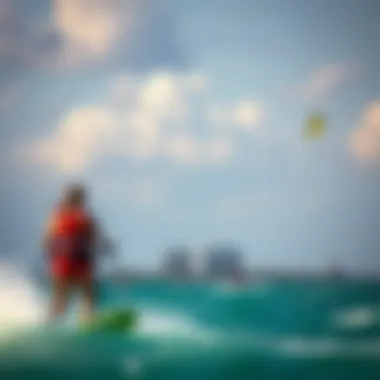
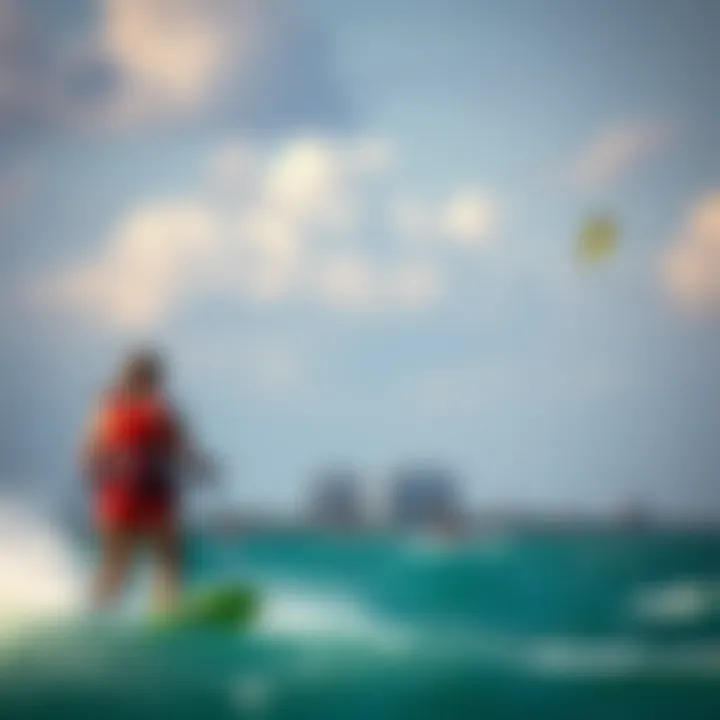
A properly accredited school will provide students with a certificate upon completion of their courses, which can be beneficial for future kite surfing endeavors abroad.
Key Points to consider regarding accreditation:
- Ensure the school follows internationally recognized safety guidelines.
- Investigate the certifications of the instructors.
- Look for reviews and testimonials on the school’s track record.
Instructor Experience and Qualifications
It’s not just a matter of having a school to learn at; the experience and qualifications of the instructors can make or break the learning experience. Enthusiastic and knowledgeable instructors can significantly enhance a student’s progress. Experienced instructors understand the challenges faced by beginners and know how to motivate students through potential setbacks.
Asking potential instructors about their background can provide insights into their capabilities. For instance, those who have participated in competitive kite surfing or have extensive teaching experience often bring enriched perspectives to their lessons.
Consider these aspects when evaluating instructors:
- Years of active kite surfing experience.
- Any relevant teaching or coaching qualifications.
- Reviews from former students regarding their teaching style and communication skills.
Curriculum and Lesson Structure
The structure and content of the curriculum can vastly influence a student’s readiness to kite surf confidently. Look for schools that offer a clear, structured lesson outline with progressive stages. This might start from basic safety procedures, moving through fundamental riding techniques, and culminating in advanced maneuvers.
A comprehensive curriculum should incorporate both practical and theoretical elements, enabling students to understand the mechanics of kite flying as well as the physics involved in riding. Lessons that emphasize safety and awareness of the environment often prepare students for the real conditions they will face outside the school environment.
Key components of a solid curriculum include:
- Initial assessments to gauge student skill levels.
- Hands-on training with immediate feedback.
- Flexibility in lesson plans to accommodate varying learning speeds.
"Proper education in kite surfing can take you from novice to adept much faster when learning at a school that emphasizes safety and a progressive approach to skills."
Essential Gear for Kite Surfing
When venturing into the exhilarating realm of kite surfing, having the right gear is mission-critical. The equipment not only influences performance but also ensures safety on the water. In Miami, where the winds dance and the waves beckon, equipping oneself properly becomes even more vital. This section dives into the essentials that will help kiteboarders—whether newbies or seasoned riders—maximize their experience and ride with confidence.
Kites: Types and Features
Kites come in an array of types, each designed for specific conditions and riding styles. Understanding their nuances can make a world of difference. Here are a few key types:
- Leading Edge Inflatable (LEI): These are the most common kites found in kiteboarding. They are versatile and provide excellent lift, suitable for beginners and experts alike. With their inflatable leading edges, they can handle a variety of wind conditions.
- Foil Kites: Unlike LEIs, foil kites are lightweight and can be packed down to a smaller size. They fly well in light winds and are frequently used for racing. However, they require a different flying technique and may not suit beginners.
- Hybrid Kites: Combining features of both LEIs and foil kites, hybrids cater to diverse conditions. They are great for freestylers who want the best of both worlds.
Features that distinguish these kites include span, aspect ratio, and material construction. Higher aspect ratio kites are more efficient and faster for jumping, while lower aspect ratios are more stable and easier to control.
Understanding these choices can help riders tailor their gear to their needs, paving the way for a thrilling kiteboarding experience.
Boards: Selecting the Right One
Choosing the right board is like finding the ideal dance partner; it should complement your style and skill level. Here’s a breakdown on what to consider:
- Beginner Boards: Wider and more stable, beginner boards help novice riders learn to balance and control their movements. They provide a forgiving ride, which is crucial for those just starting out.
- Freestyle Boards: Aimed at those looking to perform tricks, these boards are typically lighter and stiffer, offering more pop and faster response. Riders often gravitate towards these for performance-oriented kiteboarding.
- Surfboards: These boards, ideal for wave riding, are shorter and can be used with or without straps. They allow for a different experience, riding the waves rather than relying mainly on kite power.
Consider factors like board size, shape, and flex. A well-chosen board not only enhances comfort but also contributes significantly to performance in varied conditions.
Safety Gear: Helmets and Impact Vests
Safety should never take a back seat, especially while kite surfing. Engaging in a sport as exhilarating as this means preparations for unexpected turns are essential. Here’s what to prioritize:
- Helmets: A solid helmet is your first line of defense. Accidents can happen, even to the best of us. Look for helmets designed specifically for water sports. They should fit snugly and offer adequate ventilation, keeping comfort levels high.
- Impact Vests: These vests not only provide buoyancy but also protect your body from impacts during jumps or falls. A good vest should allow for freedom of movement without feeling bulky. Features like built-in flotation can add extra safety while adding comfort to the ride.
Investing in proper safety gear isn’t just about compliance; it’s about safeguarding your most valuable asset—yourself.
In summary, kite surfing in Miami is an adventure, but it’s vital to gear up wisely. With the right kites, boards, and safety equipment, kiteboarders can focus on enjoying the ride while minimizing risks. The sea is calling, and with the proper gear, there's no reason to hesitate.
Safety Protocols in Kite Surfing
Kite surfing, while offering an exhilarating blend of surfing and flying, comes with its fair share of risks. Ensuring safety is not just a precaution but a necessity for all kiteboarders, whether they are taking their first flight or navigating complex maneuvers. Understanding safety protocols is critical in mitigating risks and enhancing the overall experience. Notably, these protocols encompass everything from preparing for weather changes to having emergency procedures in place.
Understanding Weather Risks
Weather plays a pivotal role in the safety of kite surfing enthusiasts. Having a grasp of weather patterns can make the difference between a fun ride and a perilous situation. Kiteboarders must keep an eye on several meteorological elements:
- Wind Speed and Direction: Ideal conditions typically include a steady wind. Winds exceeding 25 knots can present challenges even for seasoned riders. Conversely, light winds may lead to insufficient lift, which poses its own risks.
- Storm Patterns: Sudden thunderstorms can destroy an otherwise perfect day. Always check forecasts that extend beyond immediate conditions. A solid understanding of how quickly a storm can develop is crucial.
- Water Conditions: Tides can impact the safety of your session. Low tide may expose hazards like rocks or sandbars, while high tide could increase current intensity.
By familiarizing oneself with these elements, a kiteboarder can significantly reduce the likelihood of getting caught off-guard.
Emergency Procedures
Despite diligent preparations, emergencies can still occur. Being equipped with a set of emergency procedures can be invaluable:
- Personal Safety Measures: Each kiteboarder should have a rescue plan. This includes familiarizing oneself with hand signals and communicating with fellow riders about possible hazards.
- Kite Control Skills: Practicing how to release and manage the kite in emergency situations is vital. Ideally, every kiteboarder should be comfortable with the self-rescue process, including how to limp back to shore if needed.
- Emergency Contacts: Keep essential numbers handy, such as local coast guards or rescue teams. A well-thought-out contact list can save crucial minutes during an incident.
"Staying safe is not just about protecting yourself; it's about respect for your surroundings and fellow riders."
In the world of kite surfing, respecting weather conditions and having structured emergency protocols can significantly improve the riding experience for everyone. Always remember that safety itself doesn't hinder freedom on the water but ensures your adventures can continue.
For more information on safety in kite surfing, consider checking out resources from the American Kiteboarding Association at aka.org or the Kiteboarding Association at ikitesurf.com.
Progressing from Beginner to Advanced
The transition from a novice kiteboarder to an advanced rider is not just about mastering tricks or perfecting your jumps; it embodies the entire journey of learning, improving, and ultimately enjoying the freedom that kite surfing offers. In Miami, with its unique wind and water conditions, progressing from beginner to advanced can be made both effective and exhilarating. This phase is crucial because it lays the groundwork for developing confidence, skills, and a true understanding of the sport. Each stage brings its challenges but also its rewards, paving the way for lasting enjoyment and maybe even a lifelong passion for kiteboarding.
First Steps: What to Expect
Starting kite surfing can feel like a giant leap. But don’t fret; every expert was once a beginner themselves. The initial experiences often include familiarizing one’s self with the gear, including the kite, harness, and safety equipment. Expect lessons to begin on land, where instructors will likely teach how to set up the kite, launch, and land it safely. Once on the water, beginners will learn essential skills like body dragging. This not only helps with getting comfortable with the kite but also gives a much-needed taste of what riding feels like.
- Kickoff Lessons: Most schools provide a structured curriculum starting with theory and safety basics.
- Safety First: Expect to spend a significant amount of time discussing safety protocols. Understanding the conditions and your environment is key.
- The Learning Curve: Everyone has their own pace. Some might catch on quickly; others may take longer, and that’s completely natural.
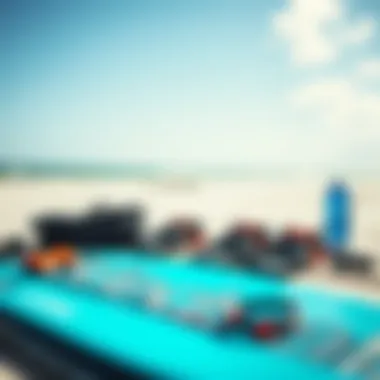
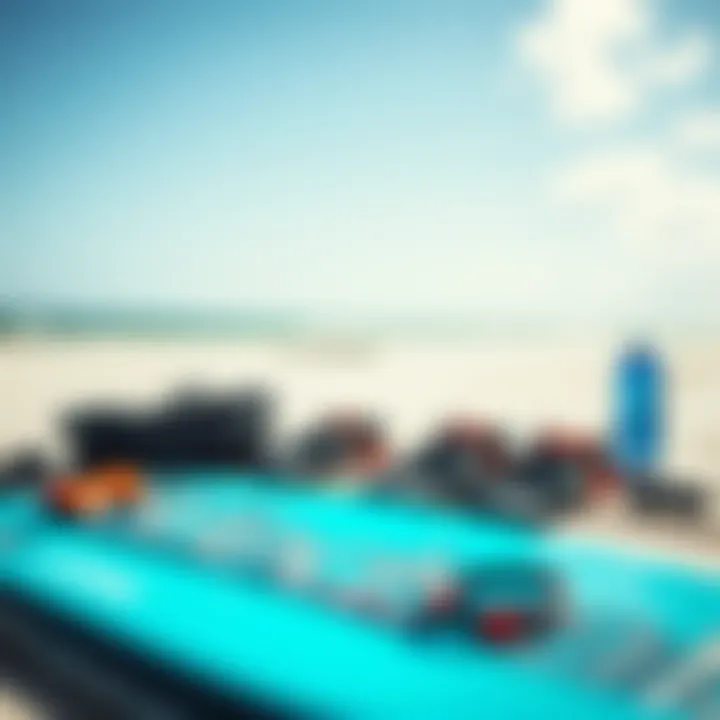
Intermediate Skills Development
As one navigates into the intermediate stage, the focus shifts from just surviving to thriving on the water. At this point, riders start picking up more technical skills and putting their knowledge into practice. This can include the critical transition from a basic body drag to actually getting onto the board. Riders are encouraged to practice their kite control while attempting to stand up and ride.
- Tips for Growth: Intermediate kiteboarders should absorb as much as they can through peer learning or advanced classes. Joining communities or getting into group lessons can also be beneficial.
- Mastering Transitions: Learning to change directions effectively becomes vital at this stage. This is where refining skills like toe-side riding and carving come into play.
- Confidence Building: Greater familiarity with water conditions and different weather scenarios will aid in boosting confidence on the board.
Advanced Techniques to Master
Reaching the advanced level in kite surfing means pushing personal boundaries and increasing awareness of environmental factors. Here, it’s not just about speed or height; it��’s about style and technique. Advanced kiteboarders often work on tricks such as jumps, spins, or even more complex maneuvers that require a deep understanding of kite dynamics and body movements.
- Progressing Your Skillset: Advanced riders work on regularly practicing their tricks and refining their style, focusing on fluidity, and the aesthetic aspects of riding.
- Riding in Varied Conditions: Experimenting in different wind and wave conditions leads to better adaptability and decision-making on the water.
- Continuous Learning: Even at this level, riders can benefit from watching others, attending workshops, or participating in competitions to further sharpen their skills.
"The experience of kite surfing evolves at every step, turning not just the sport into a passion, but the practice into art."
Local Kiteboarding Community in Miami
The kiteboarding scene in Miami isn’t just about the winds and waves; it’s a thriving community that embodies the spirit of the sport. The local kiteboarding community plays a crucial role in enhancing the overall experience of both novice and veteran kite surfers alike. From the camaraderie during practice sessions to the mentorship offered by seasoned riders, the sense of belonging can make all the difference for someone embarking on this thrilling adventure.
Social Events and Competitions
One of the standout features of Miami's kiteboarding community is the regular social events and competitions that bring people together. These events are more than just contests; they’re celebrations of skills and passion. Participants from various backgrounds gather to show off their tricks, exchange tips, and build friendships that often last a lifetime.
Events like the Miami Kiteboarding Championship draw crowds, where kiteboarders can compete in a spirited environment. Not only does this foster a competitive spirit, but it also offers a platform for kite surfers to showcase their progress and learn from one another.Through these gatherings, you might hear stories of triumph, fall, and rise again. Jumping over waves or a spectacular landing may just be part of the narrative, but it’s also about the shared joy of the sport.
You might also find casual meet-ups where the atmosphere is relaxed. These not only allow for more practice but are also an opportunity to make valuable connections within the community. Here, newcomers are not only welcomed; they're encouraged to step out of their comfort zone, try new moves, or even just have a good chat over a beer while watching the sun dip below the horizon.
Resources for Networking
In the fast-paced world of kiteboarding, networking can open doors to countless opportunities. Miami's kiteboarding community provides several resources that can help forge these connections. Social media platforms like Facebook and Instagram are bustling with groups where locals share experiences, equipment for sale, or spots where the winds are just right.
Additionally, platforms such as Reddit have dedicated sections for kiteboarding enthusiasts. Whether it's asking for gear recommendations or discussing the latest tricks, these online forums are gold mines of information and support.
Local organizations host regular meetups, workshops, and film sessions to promote community learning. They often invite experienced kiteboarders to share their expertise with those looking to improve their skills or simply gain more insight into the sport.
Here are some ways to tap into the community:
- Join local meet-ups to meet fellow enthusiasts.
- Participate in online forums to ask questions and share experiences.
- Follow local kite schools for updates on competitions and events.
"The community around kiteboarding adds dimensions you never expected. It isn't just about the sport; it is about the friendships and shared experiences that shape our journey."
In summary, embracing the local kiteboarding community in Miami not only enriches the learning experience but also creates lasting connections and memories that transcend the simple act of surfing the waves.
Recommended Locations for Kite Surfing
Choosing the right spot for kite surfing is a game changer. In Miami, where the ocean meets the sky with a vibrant wave, selecting the appropriate location can make all the difference. Whether you're a novice starting out or a seasoned pro looking to ride the wind, knowing where to go is crucial to maximize both safety and enjoyment. Let’s break down what these locations offer, the unique benefits they present, and considerations to keep in mind when heading out.
Top Spots for Beginners
For those new to the world of kite surfing, starting in a friendly environment can ease the learning curve. Miami boasts several locations ideal for budding kiteboarders:
- Crandon Park: Nestled on Key Biscayne, this spot offers shallow waters and consistent winds. The flat water is perfect for practicing skills without the intimidation of big waves or strong currents. Instructors often flock here for lessons, making it a bustling hub for beginners.
- Hobie Beach: Located in Virginia Key, this beach has ample space for newcomers to dip their toes. With its sandy shores and ample space, it’s great for practicing take-offs and landings. You’ll find kiteboarding classes available during the weekends, providing guidance right on the spot.
- Matheson Hammock Park: This tranquil park also features a lagoon, which is perfect for learners. The steady winds allow for smooth glides, giving beginners the confidence to start their kite surfing journey without overwhelming conditions.
It's wise to get familiar with your surroundings. Always check local weather patterns before hitting the waves. Remembering to stay cautious of other riders and swimmers is essential too; respect the space of those around you can enhance everyone’s experience.
Advanced Locations for Skilled Riders
Once you've mastered the basics, Miami's coastline offers several spots that cater to experienced kiteboarders eager for a challenge:
- Haulover Park: Known for its stronger winds and bigger waves, Haulover attracts experienced kite surfers keen on testing their skills. The beach is well organized for water sports, with plenty of space and infrastructure to support riders. Just be mindful of the wind direction; it can pack a punch!
- South Beach: A vibrant mix of culture and sport, South Beach offers more than just stunning views. It’s a popular surfing ground for skilled riders, particularly during the windy seasons. However, you’ll have to navigate through an array of beachgoers, which demands heightened awareness and control.
- Key Biscayne Bay: If you are after a location with challenging conditions, certain areas of Key Biscayne provide waves that can stoke the adrenaline. Here you can find both flat and choppy waters, catering to various skill levels.
When aiming for adventure, always remember that even skilled riders must stay aware of the wind and tide conditions. Take a moment to have a look around—check out where other surfers hang out, as their experience can be a gold mine of information.
"The best preparation for riding is understanding the environment. Wind can shift, currents change, and these factors are key to a thrilling ride."
With a little planning and a keen sense of safety, kite surfers can find their own blissful spot across the Miami coast. Pack your gear and get ready to embrace the winds, whether you're just starting out or pushing your limits!
Travel Considerations for Kiteboarders
When planning a kite surfing trip, especially to a bustling location like Miami, careful travel considerations become essential. Not only do these factors influence your overall experience, but they also play a significant role in ensuring that you maximize your time on the water, stay safe, and enjoy your adventure to the fullest.
From travel logistics including flight arrangements to local transportation, there's plenty to keep in mind. Factor in elements like local weather patterns and anticipated crowd sizes to make the most out of your time in the air and on the waves.
Planning Your Trip: Key Factors
Several elements warrant attention when laying out your trip. Among these, geography, seasonal wind patterns, and personal preferences can sway your experience in many ways.
- Flight Reservations: Ensure to book your flight well in advance, especially during peak seasons. Miami can get quite busy, and flights tend to fill up quickly.
- Wind Conditions: Take the time to research the typical wind conditions for your travel dates. Spot-check wind speed forecasts prior to your arrival, as fluctuating conditions can make all the difference. You might find that a trip planned during the winter offers more reliable winds.
- Water Temperature: Miami generally boasts warm waters, but if you're from colder climates, you may want to consider bringing or renting a wetsuit.
It’s smart to keep an eye out on kiteboarding forums, such as those on Reddit, for local insights or last-minute tips from fellow riders who have experienced the area.
Accommodations and Amenities
When it comes to making your stay comfortable, choosing the right accommodation can enhance your overall experience. Miami offers a wide range of options, from high-end resorts to cozy beachfront hostels.
- Proximity to Kite Spots: Select accommodations that are near popular kiteboarding spots, such as Key Biscayne or Hobie Beach, which can save you travel time each day.
- Amenities for Kiteboarders: Look for places that provide facilities like gear storage, drying racks, or even onsite kiteboarding schools. Some hotels partner with local schools, which can prove beneficial for lessons and rentals.
- Local Dining and Entertainment: After a long day on the water, it's nice to unwind. Ensure that your choice of lodgings has nearby dining options or bars to immerse yourself in the local culture. The vibrant nightlife in Miami can be a pleasant way to end a day of thrilling rides.
To make the most of your experience, consider utilizing travel apps that aggregate local reviews and recommendations for accommodations, such as Booking.com or AirBnB. Taking the time to plan in advance can transform a good trip into a great one.
"Proper planning prevents poor performance. Make sure to double-check arrangements ahead of time!"

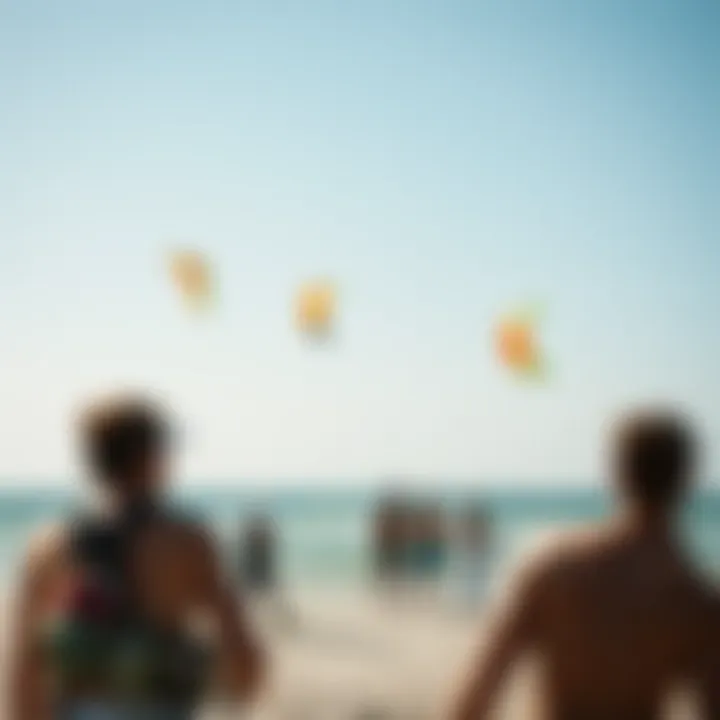
By aligning your travel considerations effectively, you're set for a kiteboarding experience in Miami that’s truly unforgettable.
Kite Surfing Regulations and Guidelines
Kite surfing, while exhilarating, demands adherence to specific regulations and guidelines to ensure safety and sustainability. Understanding these parameters is crucial not only for personal well-being but also for preserving the beauty of Miami's coastal environment. Regulations can vary by location, so it's vital to be well-informed before hitting the waves. Let's explore the essential aspects surrounding local laws related to kite surfing and best practices that contribute to responsible enjoyment of this thrilling sport.
Local Laws and Restrictions
Before you strap on your board and let the wind take you, be sure to familiarize yourself with the local laws that regulate kite surfing in the Miami area. Depending on where you choose to ride, certain areas may have specific restrictions that include:
- Designated Kite Surfing Zones: Miami has particular beaches and parks where kite surfing is permitted. Ignoring these boundaries can not only lead to fines but can disturb the local wildlife and other beachgoers.
- Time Restrictions: Some locations may limit kite surfing to certain times of the day to minimize disturbances. Typically, mornings or late afternoons are favored to avoid the high traffic of sunbathers and swimmers.
- Sufficient Distance from Others: Ensuring that you're a safe distance from other surfers, swimmers, and bystanders is essential, as kites can be unpredictable.
Adhering to these local regulations promotes a harmonious relationship between kite surfers and the community and contributes to the overall safety of the sport.
Best Practices for Responsible Riding
Engaging in kite surfing isn't just about catching the perfect wave; it also involves respecting both the sport and those sharing the environment. Implementing best practices is essential for any kite surfer aiming to enhance their riding experience while ensuring the safety of themselves and others. Here are some key suggestions:
- Conduct a Gear Check: Before each session, ensure your equipment is in good working condition. Inspect your kite, lines, and board for wear and tear.
- Learn to Navigate: Understanding local wind patterns, tides, and currents can significantly improve your control over your board and kite. Always assess the conditions before you launch.
- Follow Right of Way Rules: Like in sailing, there are established right-of-way rules in kite surfing. Familiarize yourself with these to avoid collisions and ensure everyone enjoys a safe ride.
- Respect the Environment: Avoid damaging natural habitats and take any trash back with you. Leaving a beach cleaner than you found it shows appreciation for the wonderful locations you experience.
- Stay Informed: Engage with local kiteboarding communities to keep up with changing regulations and best practices. Forums on sites like reddit.com are great for sharing insights and experiences.
Remember, kite surfing in Miami is not just an activity; it’s a culture. Being a responsible rider not only ensures your safety but enhances the experience for everyone.
By following these guidelines and understanding the local regulations, you contribute to a safer and more enjoyable kite surfing environment for all.
Learn more about kiteboarding safety from the American Kiteboarding Association and ensure your experience in Miami is nothing short of fantastic!
Personal Reflections from Experienced Kiteboarders
When delving into the world of kite surfing, the voices of those who have tread this path before us stand out as immensely valuable. Personal reflections from seasoned kiteboarders shed light on the nuances of the sport, offering insight that cannot be captured in manuals or instructional videos. The stories and lessons from these veterans are often steeped in real-world experience, showcasing not just the triumphs but also the tribulations that come with harnessing the wind and waves.
Lessons Learned Through Experience
Kiteboarding is not merely a recreational sport; it's a journey of self-discovery and skill enhancement. Many experienced kiteboarders share that their initial lessons were marked with ups and downs—sometimes literally! One common theme that emerges is the necessity of patience. Beginners often expect to master all aspects of the sport swiftly, but the reality is that kite surfing requires practice, perseverance, and a fair bit of humility.
Expectations versus reality is a significant lesson learned. Many novices have embarked on this adventure believing they would quickly be riding smooth and performing tricks within a few lessons. However, reality often unfolds differently. The wind doesn't always cooperate, and the water can behave unpredictably; many seasoned riders have faced days where they spent more time untangling lines than on their boards. This unpredictability can be frustrating, yet it's a crucial part of the learning curve.
Experienced kiteboarders underscore the importance of safety and understanding the environment. Many have come away with a deeper respect for the ocean, acknowledging that it is a powerful force. They emphasize the necessity of proper gear and awareness of weather patterns. In their reflections, they often mention moments of recklessness that led to accidents or close calls. Taking safety protocols seriously while enjoying the thrill is a juxtaposition that all riders must navigate.
Key Takeaways for Novices
For those just starting out, experienced kiteboarders offer several nuggets of wisdom that can ease the learning curve:
- Start with the Basics: Focus on foundational skills before jumping into advanced maneuvers. Understanding how to control the kite effectively is paramount.
- Connect with Others: Being part of a community can make a world of difference. Many riders highlight the friendships formed through shared experiences, which not only enrich the sport but provide assistance and encouragement when needed.
- Embrace Small Wins: Celebrate the little victories. Whether it’s standing up on the board for the first time or mastering a new trick, each accomplishment deserves recognition. Small wins build confidence and motivation to tackle more challenging aspects.
- Stay Curious and Adapt: The ever-changing nature of kite surfing demands adaptability. Be open to new techniques, feedback, and evolving with the sport.
"Each time I hit the water, I learn something new. It's about enjoying the ride and growing along the way."
— Veteran Kiteboarder
In summary, the reflections of those who have deeply engaged with kite surfing provide a unique lens through which to view the sport. Their stories and lessons resonate with countless others eager to embark on their own kiteboarding journey in Miami and beyond. Whether you’re just dipping your toes in or are planning to ride the waves, the insights shared from these kiteboarders can be your compass, guiding you toward a fulfilling and enjoyable experience.
Future of Kite Surfing in Miami
The future of kite surfing in Miami looks as promising as a sunny day at the beach. With continuous developments in equipment technology and a growing interest in the sport, Miami’s coastline is set to thrive as a premier destination for both seasoned kiteboarders and those just dipping their toes into the sport. As more schools and community groups form, the city becomes a hub for innovation and enthusiasm around kiteboarding.
One crucial area of focus is the increase in accessibility for beginners. Programs geared towards novices are popping up, ensuring that anyone can learn the ropes safely and effectively. The city is making steps to provide more lessons and certifications, making it easier for newcomers to dive into the world of kite surfing.
As we look toward future trends, understanding the local conditions is vital for both safety and enjoyment. This is particularly important in Miami, where diverse weather and water conditions can shape the kiteboarding experience. Adaptations in lesson plans, focusing on local patterns and currents, can mean the difference between a great day and one filled with frustration.
Trends and Innovations
The kite surfing scene is constantly evolving, and Miami is at the forefront of these changes. New kite technology is enhancing performance and safety for riders. For instance, advancements in kite materials are making them lighter yet stronger, enabling kiteboarders to soar higher and ride longer. This is especially beneficial for those who wish to push their limits and take on advanced maneuvers.
Additionally, innovations in board design have resulted in options that cater to various skill levels and riding styles. There are now boards specifically designed for freestyle, wave riding, and racing, meaning every rider can find a perfect match for their preferences.
As the sport gains popularity, there’s also an uptick in the use of smart technology. Wearable devices and apps now allow riders to track their performance data, analyzing aspects like speed, height, and even heart rate. With this data, kiteboarders can refine their techniques and set measurable goals, improving their overall experience.
Sustainability and Environmental Considerations
As kite surfing blossoms in Miami, so too does the awareness of our responsibility towards the environment. Given the region's delicate ecosystems, it's imperative to integrate sustainability practices within the kiteboarding community. Schools and instructors are beginning to incorporate eco-friendly approaches in their lessons, emphasizing respect for marine life and the ocean's health.
Beach clean-up initiatives led by local kiteboarding communities are also on the rise. By participating in these events, kiteboarders not only promote a cleaner environment but also foster a stronger sense of community among enthusiasts.
Furthermore, there's a growing trend toward using eco-conscious gear. Kite companies are more frequently adopting sustainable materials and production practices. Riders can now choose gear that aligns with their values, contributing to the preservation of our beaches and oceans.
"As we look forward, it’s essential to ensure the sport thrives while respecting the natural beauty we love to explore."
From investment in technology to sustainability initiatives, the future of kite surfing in Miami is more than just about riding the waves. It’s about cultivating a community that cherishes both sport and the environment, creating a lasting legacy for future generations of kiteboarders.
Finale and Final Thoughts
In wrapping up our exploration of kite surf lessons in Miami, it becomes clear that this vibrant coastal city is more than just a picturesque backdrop; it's a thriving hub for both novice riders and seasoned kiteboarders. The synthesis of optimal weather conditions, coupled with diverse locations and an enriching community, makes learning and mastering kite surfing here a unique experience. Understanding these elements not only enhances one's lessons but also lays the fertile ground for lasting connections within the kiteboarding community.
The key takeaway is that kite surfing in Miami is not solely about the sport; it's about building relationships, sharing experiences, and immersing oneself in a culture that celebrates adventure. As you navigate the stunning waters of Biscayne Bay or the iconic beaches of South Beach, remember that each session is a step towards improving your skills and expanding your horizons.
"Kite surfing is not just a sport; it’s a lifestyle that draws you in and transforms your perspective on adventure."
The warmth and enthusiasm of the local kiteboarding scene cannot be overstated. Participating in group classes or social events can provide invaluable insights, and often, a few friendly faces will make all the difference in your journey. Whether you’re just beginning or striving to perfect advanced maneuvers, the camaraderie in Miami’s kiteboarding community stands ready to support you every step of the way.
Summarizing the Kite Surf Experience in Miami
To sum it up, kite surfing in Miami is a blend of thrilling experiences, breathtaking scenery, and educational growth. Newcomers will find the support and resources they need to safely embark on their kite surfing journey, while more experienced kiteboarders will appreciate the ability to refine their skills amidst stunning landscapes. From the gentle breezes ideal for beginners on windy days to the challenging conditions favored by experts, Miami serves a diverse array of kiteboarding styles.
Additionally, understanding the significance of safety protocols and being aware of local regulations is crucial. An informed kiteboarder is not just safer, but also more confident out on the water. By continuously learning about gear selection and local conditions, riders can preserve the purity of this exhilarating sport while fostering its sustainable growth.
Encouragement for Individuals to Start
As we close this exploration, it’s vital to encourage anyone contemplating kite surfing to take that inaugural step. The enthusiasm you’ll encounter in a lesson is infectious. Even if the thought of being pulled by a kite seems daunting, remember that everyone starts somewhere. Many schools offer beginner-friendly packages specifically designed to ease new members into the thrill of kite surfing with comprehensive guidance.
Imagine the sensation of gliding over waves, guided by the wind and your own newfound skills. With the proper gear and instruction, you’ll be soaring above the water before you know it. Don’t hesitate to embrace the adventure. With every gust of wind, new challenges and rewards await. Whether for recreation or structured learning, the storyline of kite surfing in Miami is yours to weave.













